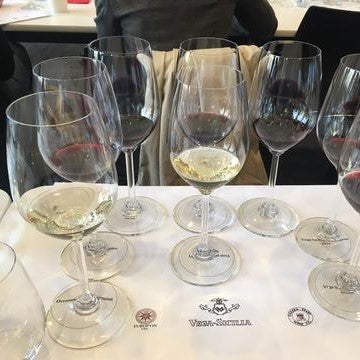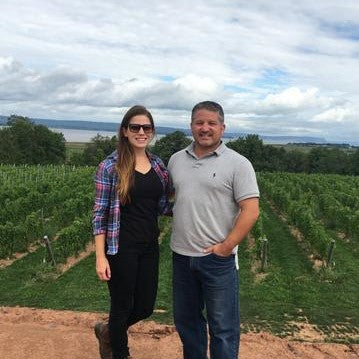Having previously known of Nova Scotia only from tales told me of Cape Breton 30 years ago by a friend who summered often there, it newly piqued my interest upon meeting in England its wine association’s representative, Gillian Mainguy, at May’s International Cool Climate Wine Symposium. The native Ontarian did her diligence talking up her adopted region, a task made easy in that the whites and bubblies she poured were both palatable and technically proficient. And despite that some were made with hybrid grapes, those made with the more recognizable (to my palate at least) vinifera were varietally correct and balanced. Huh. Another up & coming cool climate wine region to be discovered, which I did in early September.
Most of Nova Scotia’s 900 acres of vines are in the Annapolis Valley, the province’s traditional agricultural belt. Flanked by the North and South Mountain with the North blocking cold winds makes the valley long-prized for quality orchard fruit and ground crop production. Second to that, more temperate Gaspereau Valley would be even more appealing for vine production were it not for its greater susceptibility for winter kill than that of Annapolis. Avondale Sky Winery’s owner proffers that his Avon Valley enjoys the warmest winters, highest summer heat, and greatest number of frost-free days in the province though I haven’t corroborated his claim.
The imposing Bay of Fundy plays a key factor in what occurs climatically with no vineyard more than 16mi. from it or the greater Atlantic Ocean. These inure the area with ongoing damp although constant winds minimize the fostering of fungus.
The area possesses relatively diverse top- and sub-soils, with extensive research and analysis soon to be undertaken by the local Kentville Research Station. Annapolis has more sandy topsoil than Gaspereau which is mostly loamy clay; sandstone and shale with pockets of crustacean debris indicating an ancient seabed are also found. Vintage variations here are similar to that of Ontario, Michigan, New York.
Preferred varieties include:
Hybrids—L’Acadie, Seyval Blanc, Geisenheim 318, NY Muscat, Vidal, Petit Milo, Ortega, Traminette, Frontenac Gris, Triomphe Alsace, Osceola, Cayuga, Marechal Foch, Leon Millot, Baco Noir, Marquette, Lucie Kuhlmann, Castel, Precoce, Cabernet Foch
Vinfera—Chardonnay, Riesling, Siegerrebe, Chasselas, Pinot Noir, Pinot Meunier, Muscat Ottonel, Dornfelder
‘Tidal Bay’ is the brilliantly conceived and trademarked assignation launched in 2012 for blended white wines, an idea engendered by noted consultant Peter Gamble. 100% NovaScotia-grown grapes, comprised of primarily of hybrids are assigned to one of three categories of percentage-determined varieties with examples tasted by a professional panel which chooses to issue the assignation. The 12 wineries comprising the Wine Association of Nova Scotia are now using and marketing a Tidal Bay a light, crisp and aromatic dry or more typically off-dry, not exceeding 11% alc., white retailing at $20-25 per bottle. Tidal Bay is a success in great part because of it being developed when the wine region is relatively new, when the relatively small number of producers are poised to agree since they haven’t yet found their own separate ways.
Of the 20 wineries in the province 13 small farm wineries (with the national brand Peller soon to join) comprise the Wine Association of Nova Scotia, a membership-driven organization sourcing funds from membership fees, the Nova Scotia Labour Council, and the members’ production levy. Its strategic goals are currently in flux with Mainguy looking after marketing and government relations. I’m told the provincial government has in place a program financing up to half the cost of vineyard expansion.
Lots more vineyard, winery, and personnel deets to follow in the next installment!
Photo of the author and Gillian Mainguy at Luckett Vineyards.



